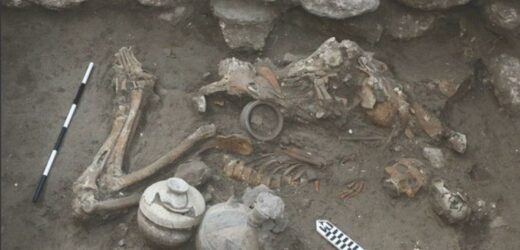Evidence for an early form of brain surgery being undertaken in the late Bronze Age has been found in the ancient city of Megiddo, in Israel. “Cranial trepanation” is the surgical practice of drilling or scraping a small hole through the skull. It is known to have been practiced for thousands of years by ancient civilisations across the globe, from Africa to South America.
Archaeologists found the remains of two brothers who lived in Megiddo in around the 15th century BC — one of who had undergone the Near East’s earliest known example of “angular notched trepanation”. This particular procedure involves cutting the scalp; using a sharp, bevel-edged instrument to carve four intersecting cuts into the skull; and finally using leverage to make a square shaped hole through the cranium.
The study was undertaken by archaeologist Rachel Kalisher of Brown University, in Rhode Island, and her colleagues.
Ms Kalisher said: “We have evidence that trepanation has been this universal, widespread type of surgery for thousands of years.
“But in the Near East, we don’t see it so often — there are only about a dozen examples of trepanation in this entire region.
“My hope is that adding more examples to the scholarly record will deepen our field’s understanding of medical and cultural dynamics in ancient cities in this area.”


According to paper co-author and archaeologist Professor Israel Finkelstein of the University of Haifa, some 4,000 years ago Megiddo was located along and controlled part of the Via Maris, an important trade route that linked Egypt, Syria, Mesopotamia and Anatolia.
Because of this, by the 19th century BC, the city had become one of the most cosmopolitan and wealthy in the region — sporting an impressive array of fortification, palaces and temples.
Prof. Finkelstein said: “It’s hard to overstate Megiddo’s cultural and economic importance in the late Bronze Age.”
The remains of the two brothers analysed by the researchers came from a domestic area located adjacent to Megiddo’s late Bronze Age palace — suggesting that the pair were at least elite members of society, if not royals themselves.
This interpretation is supported by how the duo were buried with various valuable grave goods — including a selection of fine Cypriot pottery — and also appear to have received medical treatments, like the trepanation, that likely would not have been accessible to most of Megiddo’s citizens.


Ms Kalisher explained that both brothers — one of whom died in his teens or early 20s, and the other between his 20s and 40s — appear to have suffered from severe skeletal abnormalities.
One, for example, had both an additional cranial suture and an extra molar in one corner of his mouth, suggesting that he might have suffered from a congenital syndrome such as Cleidocranial dysplasia.
The bones of both, meanwhile, exhibited evidence of sustained iron deficiency anaemia during childhood, which likely impacted their development.
Despite these issues, however, the researchers believe that the brothers likely died as the result of an infectious disease.
In fact, a third of one of the skeletons and half of the other’s exhibit porosity, legions and signs of previous inflammation in the membranes surrounding the bones, suggesting that they likely had systemic, sustained cases of a disease like tuberculosis or leprosy.
DON’T MISS:
Man unearths family’s buried treasure from WW2 after following map [REPORT]
Heat pump blow as Government blamed for ‘disappointing’ £450mn scheme [INSIGHT]
Vibrating capsule that ‘stirs colon to action’ alleviates constipation [ANALYSIS]

According to Ms Kalisher, it is difficult to identify cases of leprosy from skeletal remains alone — which is why she is teaming up with researchers from the Max Planck Institute for Evolutionary Anthropology in Germany to undertake genetic analysis of some of the lesions.
If bacterial DNA is found consistent with leprosy, the pair will be among the earliest known examples of leprosy in the world.
Ms Kalisher said: “Leprosy can spread within family units, not just because of the close proximity, but also because your susceptibility to the disease is influenced by your genetic landscape.
“At the same time, leprosy is hard to identify because it affects the bones in stages, which might not happen in the same order or with the same severity for everyone. It’s hard for us to say for sure whether these brothers had leprosy or some other infectious disease.”

It is also difficult, the researchers said, to know if it was the disease, the birth defects or something entirely different that led one of the men to have cranial surgery.
Whatever the reason, Ms Kalisher said, the procedure didn’t work — with evidence suggesting he died within days, hours or even minutes of the procedure.
Archaeologists are not entirely sure what ancient peoples were intending to treat with trepanations, or why some of the trepanation holes were round in shape while others were square (like in the Megiddo case) or triangular.
It should be noted there’s a modern procedure known as a “craniotomy” which surgeons use to relieve pressure on the brain.
With the current research complete, Ms Kalisher is undertaking a follow-up study exploring the practice of trepanation across multiple regions and time periods.
She said: “You have to be in a pretty dire place to have a hole cut in your head.
“I’m interested in what we can learn from looking across the scientific literature at every example of trepanation in antiquity, comparing and contrasting the circumstances of each person who had the surgery done.
Ms Kalisher said that she hopes the findings of her current study will show people that ancient societies didn’t necessarily live by the principles of “survival of the fittest”.
She explained: “These brothers were obviously living with some pretty intense pathological circumstances that, in this time, would have been tough to endure without wealth and status.
“If you’re elite, maybe you don’t have to work as much. If you’re elite, maybe you can eat a special diet. If you’re elite, maybe you’re able to survive a severe illness longer because you have access to care.”
“In antiquity, there was a lot more tolerance and a lot more care than people might think. We have evidence literally from the time of the Neanderthals that people have provided care for one another, even in challenging circumstances.
“I’m not trying to say it was all kumbaya — there were sex- and class-based divisions. But in the past, people were still people.”
The full findings of the study were published in the journal PLOS ONE.
Source: Read Full Article


